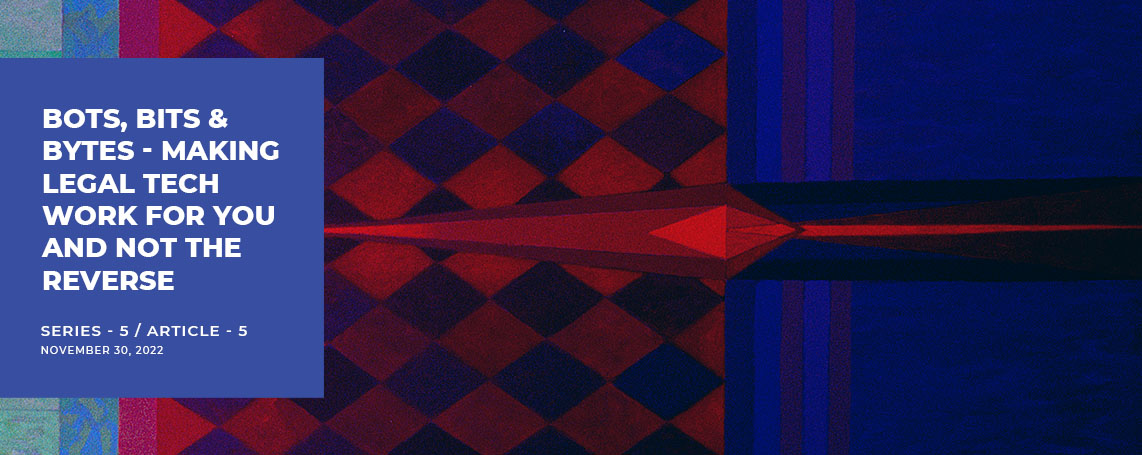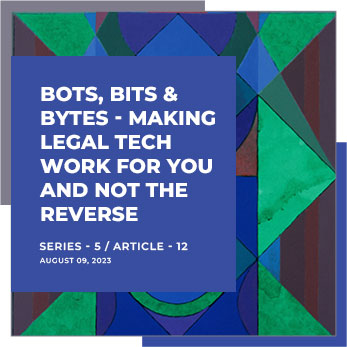A young lawyer dies and goes to Heaven. He tells St. Peter: ‘There must be some mistake! I’m only 35!’ The angel looks at his records and responds: ‘according to your billed hours, you’re at least 85!’
It’s not clear what will happen to classic lawyer jokes if human lawyers really get replaced by robot lawyers, but one thing seems certain—billable hours to the client will go way down. That prediction was realized recently when Morgan Stanley turned to robot lawyers to review and revise trillions of dollars’ worth of LIBOR contracts upon the expiration of that floating rate benchmark.
The investment banking firm claims to have saved 50,000 hours and $10 million in legal fees using robot lawyers. AI and robotics are, at the very least, supplementing legal work. But will they actually be able to replace human lawyers? The jury—or the jQuery—is still out on that.
Bots and Robots
Cyborgs, androids, chatbots, robots, and codebots…the world of AI systems can indeed be very confusing. Simply put, ‘robots’ have a physical body of some sort, and they include ‘cyborgs’, ‘androids’, and the industrial robots that build pretty much everything on today’s assembly lines. ‘Bots’, on the other hand, are without a physical body, and ‘chatbots’ and ‘codebots’ fall into that category. Put another way, ‘robot’ refers to a programmable machine that can perform amazingly complex actions, while a ‘bot’ is strictly a program or app that does pretty much the same thing.
Got it? If not, that’s ok because we are moving on to what all of this will mean the day a “Completely Automated Public Turing test to tell Computers and Humans Apart” (better known as a CAPTCHA challenge) displays: “Prove you are not a human.”
A ‘Legal Aid’ for Clients
Billed as the ‘first robot lawyer’ the “DoNotPay” app was developed by Joshua Browder who, at age 18 got tired of coming up with novel ways to fight his ever-mounting London parking tickets and figured there had to be a better way than hiring lawyers. He discovered that if the defendant knows what to say in his defense, the chances of beating the ticket increase accordingly. He commercialized this notion with his app in 2015 but didn’t stop there. His 150,000 paying subscribers can now get help with everything from insurance claims to terminating health club memberships and applying for visas.
Perhaps surprisingly, the DoNotPay app won an award from—of all places—the American Bar Association on account of its success in furthering access to legal assistance. (Will ‘ABA’ eventually come to mean ‘American Bot Association’?)
Skip the Contracts Attorney
Also hailing from the UK is LISA—touted as ‘the world’s first impartial robot lawyer.’ It (or he, or she…hard to tell) consists of AI technology enabling the client and another party to draft legally binding agreements, all while remaining impartial and dealing with ‘just the facts ma’am’ in the course of reaching the coveted middle ground of contractual consensus. Human lawyers, of course, would likely face a conflict of interest and other Professional Responsibility liabilities if he or she would risk trying to represent both sides in a complex commercial transaction. Whether LISA will be subject to those same Model Rules remains to be seen. But the strong argument in favor of using LISA—apparently adopted by various brand-name companies—is the enormous savings.
Robot Revolution
Like the Industrial Revolution and the Information Age before it, the Robot Revolution is all about change leading to progress. But it is this latter factor that still has some skeptics resisting the adoption of robot lawyers. Sure, lawyerly tasks such as research, drafting, document review, and even advising clients may certainly be assisted through the use of AI in one form or another; yet, there remain—either theoretically or practically—functions that only a human lawyer can do.
In a research project carried out by a group of law professors, a robot was tasked with analyzing legal briefs and judges’ opinions for text analysis and features of successful versus unsuccessful cases. In the sample citation of “Brown v. Board of Education 347 U.S. 483 (1954)”, the machine learning algorithms stumbled in the maze of punctuation included in the citation.
Half a Robot Lawyer Still a Threat
Proponents of robot lawyering point out that there is no need to completely automate in order for AI to make partners at a prestigious law firm; rather, partial automation will be enough to lengthen human-attorney unemployment lines. Like Morgan Stanley, Goldman Sachs also used robot lawyers for LIBOR transitioning and found that for this type of legal functioning, ML performed exceptionally well: what would have taken ‘an army of [human] lawyers’ a year, maybe two, was carried out within just one business quarter.
But will a robot really take your job? And what are the ethical ramifications of sending such an associate into court, a real estate closing, or an M&A conference? These are among the questions raised in the book AI for Lawyers: How Artificial Intelligence is Adding Value, Amplifying Expertise, and Transforming Careers by authors Waisberg and Hudek, which purports to provide a guide for firms contemplating reserving that corner office for a robot.
Does it Make Sense Financially?
Another argument against the use of robots in the law firm is precisely the argument favored by clients: significantly reduced billable hours. Unless firms make the strategic shift to only using value-billing pricing for legal work, the conventional bread-and-butter ‘billable hour’ method that made lawyering so profitable in the first place will be greatly eroded.
Just ask that 35-year-old lawyer who confronted St. Peter…
Executive Summary
The Issue
Are robot attorneys really coming to replace human attorneys?
The Gravamen
A significant number of legal practice functions can, in fact, be carried out by highly sophisticated algorithms—whether contained in a machine robot or residing in a bot—and these ‘associates’ have already proven themselves in the field via LIBOR transitioning.
The Path Forward
Incorporating robots as part of a firm’s value to clients is a step in the march of professional progress that appears to be inevitable.
Action Items
What Tasks?:
ML assistance is not yet applicable to all legal practice functions, and a careful analysis will have to be made to determine what the AI attorney can handle.
Client Receptiveness:
Behind the scenes is one thing, but if at some point a firm anticipates actual client interfacing with a robot, that move must not be taken lightly, or client backlash could result.
Ethics Liability:
As robots, in fact, come to be increasingly incorporated into the practice of law, Model Rules of Professional Responsibility will need to be adopted to address such a phenomenon.
Bottom-Line Billing:
An actuarial assessment will need to be conducted to arrive at the proper balance of robot-time billing versus human-lawyer hourly billing in order to maintain firm profitability.
Further Readings
- https://theconversation.com/robots-are-coming-for-the-lawyers-which-may-be-bad-for-tomorrows-attorneys-but-great-for-anyone-in-need-of-cheap-legal-assistance-157574
- https://www.bbc.com/news/business-58158820
- https://www.golegal.co.za/robots-lawyer-ai/
- https://www.bloomberg.com/news/articles/2021-10-22/morgan-stanley-s-robot-libor-lawyers-saved-50-000-hours-of-work
- https://www.abajournal.com/books/article/podcast-episode-144
- https://legaltalknetwork.com/podcasts/legal-toolkit/2018/11/robot-takeover-how-automation-makes-law-practice-easier/







